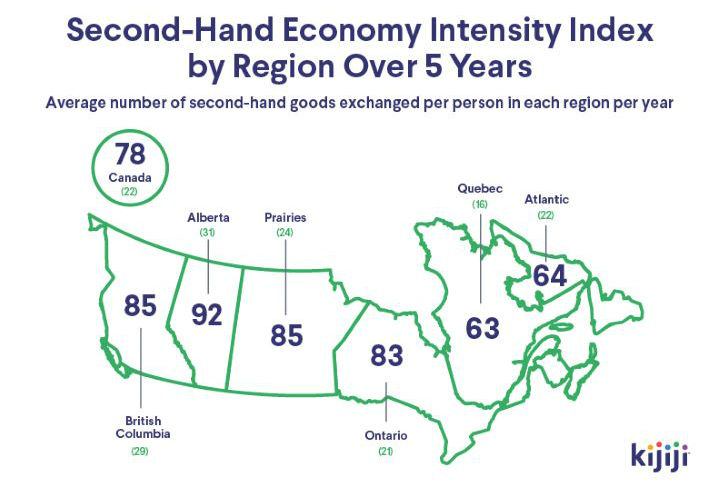Canada’s second-hand economy has grown steadily over the last several years, a new report says.

Second-hand transactions accounted for 1.23 per cent of the country’s GDP in 2018, according to a recent report released by Kijiji and conducted by professors at the University of Quebec.
“This is the fifth year that we’re doing the study,” said Marie Connolly, one of the economic professors who conducted the survey at the University of Quebec.
“The proportion of Canadians that engage in the second-hand economy, in one way or another, has maintained itself in a little bit over 80 per cent every year.”
What has changed, Connolly noted, is people’s motivations for participating in the second-hand economy.
The top reason people use the second-hand market is for financial reasons, but according to the report, more people have been participating due to altruistic and ecological motivations.
“What’s been on the increase is the number of people that mention some other motivation, such as altruistic, like, ‘I want to do something good for the community, for other people around me,’ and ecological, which is, ‘I don’t want to see things go to waste. I don’t want to use up new resources,'” Connolly said.
According to the report, Canadians have earned an average of $961 and saved an average of $723 each year over the last five years through second-hand items.
Moreover, the average number of items each Canadian has acquired or disposed of in the second-hand economy during the year has increased since 2014, the report reads.
“I think what’s made it very easy, nowadays especially, is in part by new technology, in platforms that really connect buyers and sellers,” said Kent Sikstrom, Kijiji’s spokesperson and community relations manager.

Get breaking National news
“You have apps, you have online classifieds, you have social media, things like that.”
Another reason why people are now participating in the second-hand market, he added, is due to changes in attitudes toward used goods.
“The idea of buying something second-hand maybe wasn’t as a desirable as it is today,” Sikstrom said. “We’re seeing that, more and more, the second hand economy is almost a go-to place for people.”
According to the report, young people, age 45 and under, are the most active generation in the second-hand economy, with 88 per cent of them participating, compared to 82 per cent of the overall population.
For Connolly, the second-hand market isn’t a “fad” and is here to stay.
“It’s something that’s very well in our lifestyles, and that’s going to stay there and perhaps keep growing with ease of using platforms like Kijiji,” she said.
Methodology: The survey was conducted online for the Observatoire de la consommation responsable (OCR) of the Université du Québec à Montréal (UQAM) in partnership with MBA Recherche between September 18, 2018, to October 12, 2018. Primary data were collected using a sample of 5,625 respondents aged 18 and older representative of the Canadian population. Respondents were selected from a pan-Canadian Web panel according to pre-specified retention criteria such as gender, age and place of residence. Given that responses were obtained from a panel, computation of the margin of error does not apply.










Comments